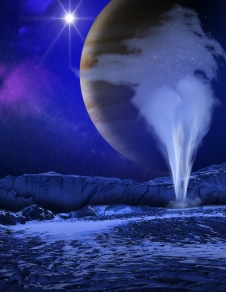
NASA's Hubble Space Telescope has observed water vapor above the frigid south polar region of Jupiter's moon Europa, providing the first strong evidence of water plumes erupting off the moon's surface.
Previous scientific findings from other sources already point to the existence of an ocean located under Europa's icy crust. Researchers are not yet fully certain whether the detected water vapor is generated by erupting water plumes on the surface, but they are confident this is the most likely explanation.
Should further observations support the finding, this would make Europa the second moon in the solar system known to have water vapor plumes. The findings were published in the Dec. 12 online issue of Science Express, and reported at the meeting of the American Geophysical Union in San Francisco.
"By far the simplest explanation for this water vapor is that it erupted from plumes on the surface of Europa," said lead author Lorenz Roth of Southwest Research Institute in San Antonio. "If those plumes are connected with the subsurface water ocean we are confident exists under Europa's crust, then this means that future investigations can directly investigate the chemical makeup of Europa's potentially habitable environment without drilling through layers of ice. And that is tremendously exciting."
In 2005, NASA’s Cassini orbiter detected jets of water vapor and dust spewing off the surface of Saturn’s moon Enceladus. Although ice and dust particles have subsequently been found in the Enceladus plumes, only water vapor gases have been measured at Europa so far.
To read more visit http://www.nasa.gov/content/goddard/hubble-europa-water-vapor/index.html#.UqoQQXembyB
Source: NASA News Release